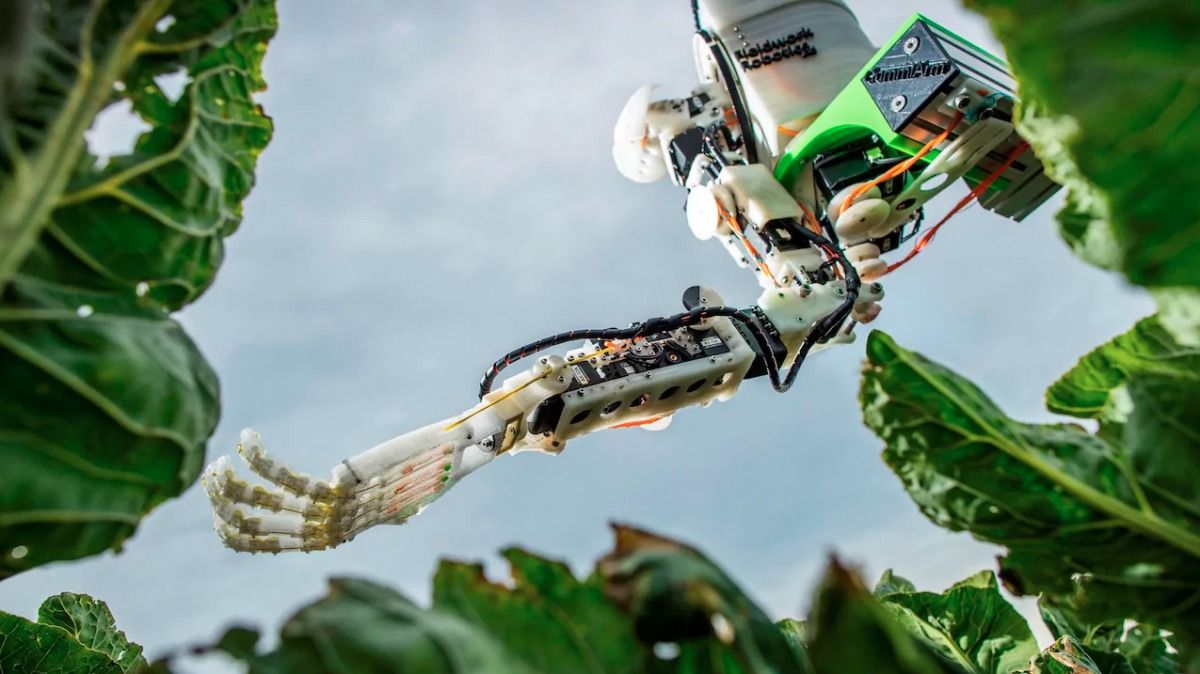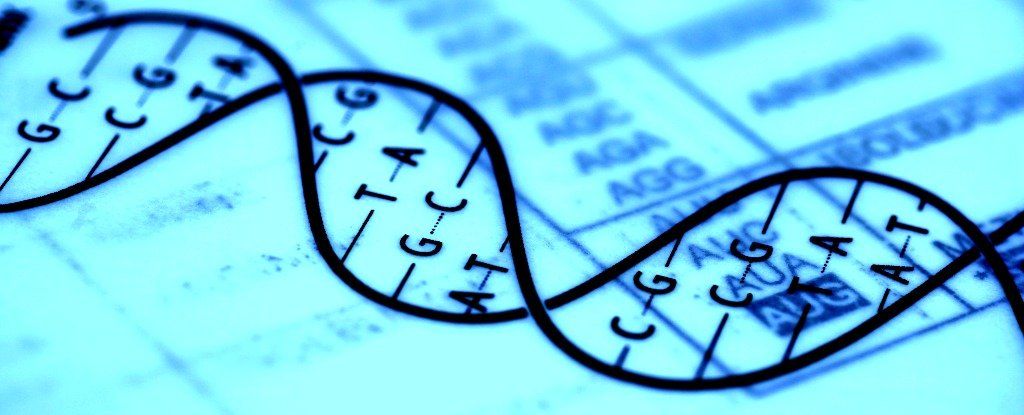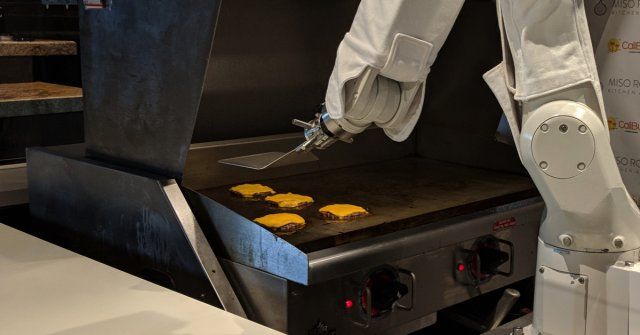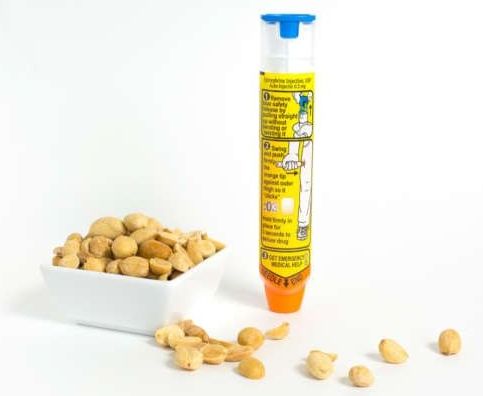While bee populations dwindle at an alarming rate, Walmart made a surprising move in filing a patent for robot bees to act as agricultural pollinators.
Category: food – Page 314
The freshest herbs in Manhattan were grown in this office building basement
New York City’s discerning high-end chefs often ship in rare herbs and edible flowers from other states or even overseas. But Farm.One, an organic farm in the basement of an office building in Manhattan, can pick and deliver the precious leaves and flowers within the same day, says Robert Laing, the company’s CEO.
With its stacked shelves of hydroponic plants and grow lights, Farm. One is part of a growing movement of vertical farming across the world. The tech-enabled system uses less space and water than traditional farming.
Watch the video above to learn more about how it works.

This cauliflower-picking robot aims to make up for a shortage of human labor in the UK
Meet GummiArm, the soft-handed robot that could fill in for a lack of human crop pickers—if British farmers can afford the cost.
The problem: The Telegraph notes that 40 percent of the growing costs for cauliflower, and similar crops like cabbage and broccoli, comes from harvesting in the UK. And that could rise, as crop-picking labor supply is set to decline in the country following Brexit.
Robots could help: University of Plymouth researchers say their GummiArm bot can pick up the slack. Computer vision allows it to work out which vegetable it should try to pick, while its hand can become more or less stiff to gently pick brassicas from their stems. It’s currently being tested in fields in southwestern England.

Gene Editing Just Got So Precise, Researchers Can Change Single Letters of DNA Code
MhAX, or Microhomology-Assisted eXcision.
Gene editing has the power to completely reshape our world.
It promises everything from fixing the genetic faults that lead to disease, to destroying disease-causing microbes, to improving the nutrition of the foods we eat and even resurrecting extinct species like the wooly mammoth — all largely thanks to the genetic editing tool CRISPR, which has both popularized this work and made it possible.
Now, researchers in Japan have developed a new gene editing technique that uses CRISPR alongside a DNA repair system to modify a single DNA base in the human genome, with what the team’s press release calls “absolute precision.”

Zoltan Istvan for CA Governor
My free event tomorrow w/ free food in San Francisco at Stock and Trade, 4-6PM. Come here me talk transhumanism and politics, and ask questions. Network TV is on hand to film it and would love to hear from you. Free tickets are below:
The Libertarian Party of San Francisco invites you to join us as we host Zoltan Istvan in his run for governor of California. Come and discover Zoltan’s unique perspective on Libertarianism and Transhumanism, and learn how he is working to spread these ideas in California and across the nation.
Join us at Stock in Trade where you will hear Zoltan speak and have an opportunity ask questions, followed by plenty of time to socialize with other LIbertarians. We will provide appetizers and addtional food and drinks are available for purchase from the bar.
This event will also be receiving media coverage from a major outlet, and they will want to hear from us!
Space is limited, so you must reserve your ticket. For questions, please send an email to [email protected].

No Refrigeration Necessary: New Tech for Everlasting Shelf-Life
There’s hope for a tastier, healthier, more robust tomorrow: high-tech new food preservation methods that fend off the bad stuff (bacteria, spoilage) while protecting the good (flavor, texture, nutrients). Scientists are experimenting with everything from microwave sterilization to blasts of plasma to ensure food stays appetizing longer—even without refrigeration. That salmon dinner you bought on Monday? It’ll taste just as fresh a week later. And it’ll be just as good for you.
Best for: Berries, nuts Scientists at Scotland’s University of Strathclyde pioneered a technique that bombards fluids with high-intensity blue light, which produces a form of oxygen that’s lethal to pathogens. It’s now being adapted for use on berries and other foods.
Best for: Eggs The USDA has developed a machine for eliminating salmonella in fresh eggs. Electrodes pulse radio frequency waves through the shells, targeting the space between the white and yolk where salmonella dwells.

Flippy the Burger Flipping Robot Is Now Cooking at the CaliBurger Fast Food Chain
A burger-flipping robot named Flippy is now cooking up hamburgers at a fast food restaurant called Caliburger.
A robot named Flippy is now in the kitchen at a fast food restaurant called CaliBurger in Pasadena. We were there for a preview event where Flippy made us some lunch.
Follow KTLA Tech Reporter Rich DeMuro on Facebook or Twitter for cool apps, tech tricks & tips!
Inside the Quest to Make Lab Grown Meat
Food scientists and startups are trying to make meat more ethically appealing by growing it — cell by cell — in a lab instead of on a farm. Even some vegans support so-called “clean” meat. But can lab grown meat overcome the dreaded “yuck factor?”
Still haven’t subscribed to WIRED on YouTube? ►► http://wrd.cm/15fP7B7
ABOUT WIRED
WIRED is where tomorrow is realized. Through thought-provoking stories and videos, WIRED explores the future of business, innovation, and culture.
Inside the quest to make lab grown meat | WIRED.

Daily Pill Shows Promise For Alleviating Life-Threatening Peanut Allergies
Imagine constantly worrying that something you eat is going to cause your throat to swell shut or your heart to stop beating. That’s the reality people with severe peanut allergies must live with every day, because their bodies launch out-of-control immune responses against even a trace of peanut protein.
But now, relief may be on the horizon. A phase 3 clinical trial by pharmaceutical company Aimmune Therapeutics shows that gradual and methodical exposure to purified peanut protein can train the body to drastically tone down the reaction. After one year of daily treatment with the company’s peanut protein-filled capsules, currently called AR101, study participants could safely tolerate 30 times more allergen than they could before the trial began.
The trial included 496 children aged 4 to 17 with allergies so severe that they could not ingest more than 30 milligrams of peanut protein without experiencing moderate to highly dangerous effects. For reference, one peanut contains 250 to 350 milligrams of peanut protein.